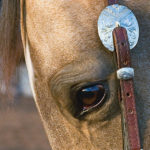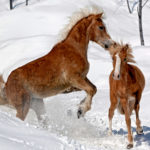How could fear be a necessary part of horses? And how could I, someone who helps people deal with their fear around horses, say it is necessary? Well, let me explain:
Horses are wonderful and beautiful…and frightening and can be very dangerous. We all know this, yet we willingly take the risk every time we walk into the barn. I’ve never met a horseperson who didn’t have at least one gnarly story about an accident or injury he or she has had from a horse. If you sufferfrom anxiety and fear with your horse, then this is for you. I hate suffering, and feel that everyone has enough mental and physical ability to reduce anxiety to make it possible to actually enjoy horses.
Fear is defined as a natural response to an actual threat. Fear is considered an emotion, but don’t let that minimize the importance of it and the role it plays in our survival. Without fear, we have no system to keep us safe from a threat. So while it is an incredibly uncomfortable emotion, it is ultimately a lifesaver. The good news is that what most of us reallyexperience around horses is anxiety. Anxiety is defined as a response to a perceived threat. The interesting part is that we have the exact same physical response to anxiety as we do to fear, and this is what can cause trouble.
If all this mess occurs from our fear, why is it necessary? “Healthy” fear keeps us safe because we avoid doing things that frighten and can hurt us. The key is to be able to distinguish between fear and anxiety so you can make powerful decisions.
Start by making a few lists. I love lists. Why? First, when you make a list with pen and paper, you access deep parts of the brain for both recall and future memory storage. Second, it helps you remember what you are working on or supposed to be doing. You have it on paper so you don’t have to worry about remembering it. Third, lists are excellent for organization of both thought and action. Many times, we have so many thoughts about something that it becomes difficult to sort it out. Putting it into categories or lists can help you organize your thoughts and your actions. Lists also help to remove the emotion from a subject so you can pull back, look at it objectively and think about it from the rational side of your brain.
Begin by making a list of what you fear versus what makes you anxious. We all have fears and we all have anxieties, but I want you to work hard to distinguish between the two. If you sit down to do this and draw a complete blank, just keep at it until your fears and anxieties start to emerge. They don’t have to be debilitating to have an impact on you and your performance. So if you are reading this and saying to yourself that yours are not bad enough for you to engage in this exercise, give it a try anyway. Once you have the list or the beginnings of one, you need to do some work on it. For items in the fear category: What kind of decisions do you need to be prepared to make? This is an important question and will help keep you safer—which comes from excellent decision-making. For the items in the anxiety category, there is much more work to do. Remember, anxiety is about perceived threat.
What I have discovered in the horse world is that this kind of worry comes from either a lack of necessary skills or a lack of connection to actual skills.
The follow-up list for anxiety is one that I like to call “What do I have the goods for?” What are you good at when you are on, near, around or with your horse? I find that when many of us allow our anxiety to take over, we forget about the skills and abilities that we do actually posess. When you can connect to your skill set, then you are empowered by all the skills you have and just aren’t accessing. The other side of that is to also connect to the skills you don’t have and either go to work on them or make decisions around them. This power of information allows for excellent decision-making and safety, which are major components in having a positive, successful horse experience. It takes work to make a change, and it takes time for it to work. Be patient and persistent with yourself and your process because you and your relationship with your horse are worth it.
Next month: Connection. And not just with the bit!
Jenny Susser has a doctoral degree and is licensed in clinical health psychology, specializing in sport psychology. A four-year All-American swimmer at UCLA, she swam on two national teams and at the 1988 Olympic Trials. She has worked with collegiate, professional, international and amateur athletes of all sports and ages. She was the sport psychologist for the 2010 WEG South African ParaDressage Team and the 2012 U.S. Olympic Dressage Team. Dr. Jenny is also a performance coach with the Human Performance Institute, delivering corporate trainings. She remains active out of the pool these days by running and riding her horses (JennyRSusser.com).





